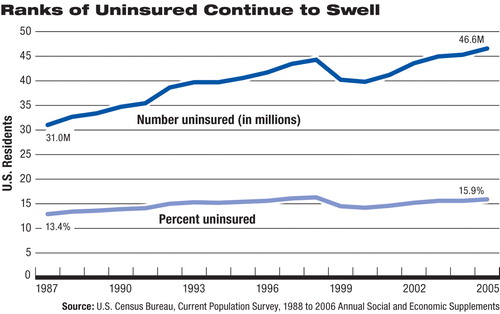U.S. Insurance Crisis Gets Pessimistic Prognosis
The percentage of people who are living in the United States and do not have health insurance coverage rose from 15.6 percent in 2004 to 15.9 percent last year, according to a report from the U.S. Census Bureau.
In addition, the percentage of people covered by employment-based health insurance declined from 59.8 percent to 59.5 percent, or 174.8 million people, according to the report “Income, Poverty, and Health Insurance Coverage in the United States: 2005.”
The data were collected in the 2006 Annual Social and Economic Supplement to the Current Population Survey by the U.S. Census Bureau.
The number of people with health insurance coverage increased by 1.4 million, for a total of 247.3 million, and the number without such coverage increased by 1.3 million, for a total of 46.6 million (see chart).

The proportion and number of uninsured children increased from 10.8 percent to 11.2 percent and from 7.9 million to 8.3 million, respectively.
AMA President J. Edward Hill, M.D., commented in a press statement,“ As the decrease in employment-based health insurance continues, the AMA renews its call for health insurance solutions that put patients in the driver's seat, along with their physicians. The cornerstones of the AMA plan for reducing the ranks of the uninsured advocate expanded coverage and choice through refundable tax credits inversely related to income, individually selected and owned health insurance, and a wide range of new, affordable insurance options.”
Among other findings:
The uninsured rate, as well as the number of uninsured, remained unchanged for non-Hispanic whites (at 11.3 percent and 22.1 million) and for blacks (at 19.6 percent and 7.2 million). The rate for Asians increased to 17.9 percent, up from 16.5 percent in 2004. The number of uninsured Asians was 2.3 million, up from 2 million. | |||||
The uninsured rate for people born in the United States increased from 13.1 percent to 13.4 percent. The uninsured rate for foreign-born people was statistically unchanged at 33.6 percent. | |||||
There were 19.8 million uninsured people in the South, compared with 12.4 million in the West. The approximate numbers of uninsured were 7.8 million in the Midwest and 6.7 million in the Northeast. | |||||
Uninsured rates for 2003-2005 using a three-year average show that Texas (24.6 percent) had the highest percentage of uninsured, while Minnesota (8.7 percent) had the lowest. Minnesota's rate was not statistically different from that of Hawaii (9.5 percent). | |||||
“Income, Poverty, and Health Insurance Coverage in the United States: 2005” is posted at<www.census.gov/prod/2006pubs/p60-231.pdf>.▪



